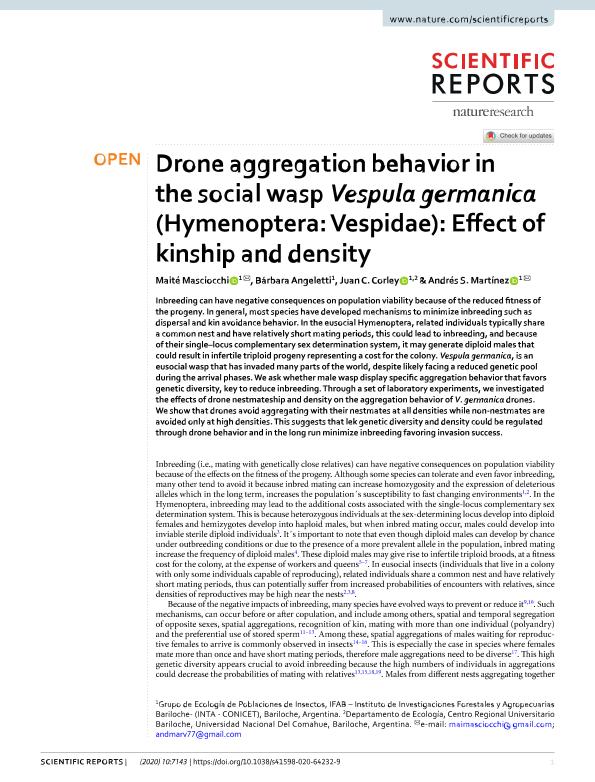Artículo
Drone aggregation behavior in the social wasp Vespula germanica (Hymenoptera: Vespidae): Effect of kinship and density
Masciocchi, Maité ; Angeletti, Bárbara; Corley, Juan Carlos
; Angeletti, Bárbara; Corley, Juan Carlos ; Martinez Von Ellrichshausen, Andres Santiago
; Martinez Von Ellrichshausen, Andres Santiago
 ; Angeletti, Bárbara; Corley, Juan Carlos
; Angeletti, Bárbara; Corley, Juan Carlos ; Martinez Von Ellrichshausen, Andres Santiago
; Martinez Von Ellrichshausen, Andres Santiago
Fecha de publicación:
04/2020
Editorial:
Nature Publishing Group
Revista:
Scientific Reports
e-ISSN:
2045-2322
Idioma:
Inglés
Tipo de recurso:
Artículo publicado
Clasificación temática:
Resumen
Inbreeding can have negative consequences on population viability because of the reduced fitness of the progeny. In general, most species have developed mechanisms to minimize inbreeding such as dispersal and kin avoidance behavior. In the eusocial Hymenoptera, related individuals typically share a common nest and have relatively short mating periods, this could lead to inbreeding, and because of their single?locus complementary sex determination system, it may generate diploid males that could result in infertile triploid progeny representing a cost for the colony. Vespula germanica, is an eusocial wasp that has invaded many parts of the world, despite likely facing a reduced genetic pool during the arrival phases. We ask whether male wasp display specific aggregation behavior that favors genetic diversity, key to reduce inbreeding. Through a set of laboratory experiments, we investigated the effects of drone nestmateship and density on the aggregation behavior of V. germanica drones. We show that drones avoid aggregating with their nestmates at all densities while non-nestmates are avoided only at high densities. This suggests that lek genetic diversity and density could be regulated through drone behavior and in the long run minimize inbreeding favoring invasion success.
Archivos asociados
Licencia
Identificadores
Colecciones
Articulos (IFAB)
Articulos de INSTITUTO DE INVESTIGACIONES FORESTALES Y AGROPECUARIAS BARILOCHE
Articulos de INSTITUTO DE INVESTIGACIONES FORESTALES Y AGROPECUARIAS BARILOCHE
Citación
Masciocchi, Maité; Angeletti, Bárbara; Corley, Juan Carlos; Martinez Von Ellrichshausen, Andres Santiago; Drone aggregation behavior in the social wasp Vespula germanica (Hymenoptera: Vespidae): Effect of kinship and density; Nature Publishing Group; Scientific Reports; 10; 1; 4-2020
Compartir
Altmétricas



